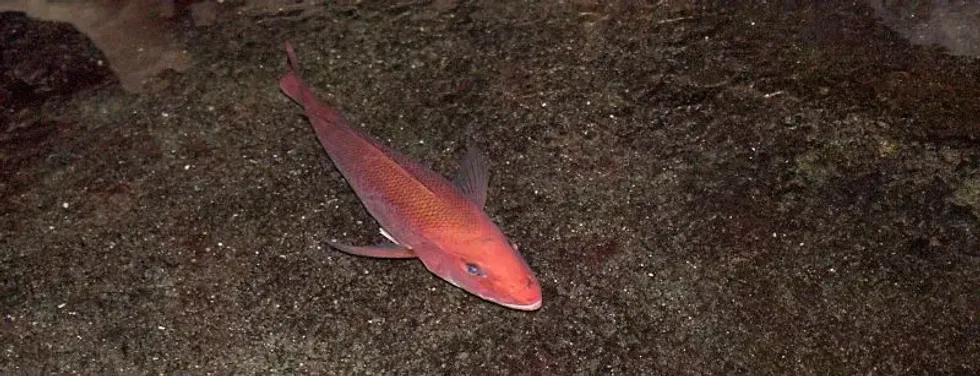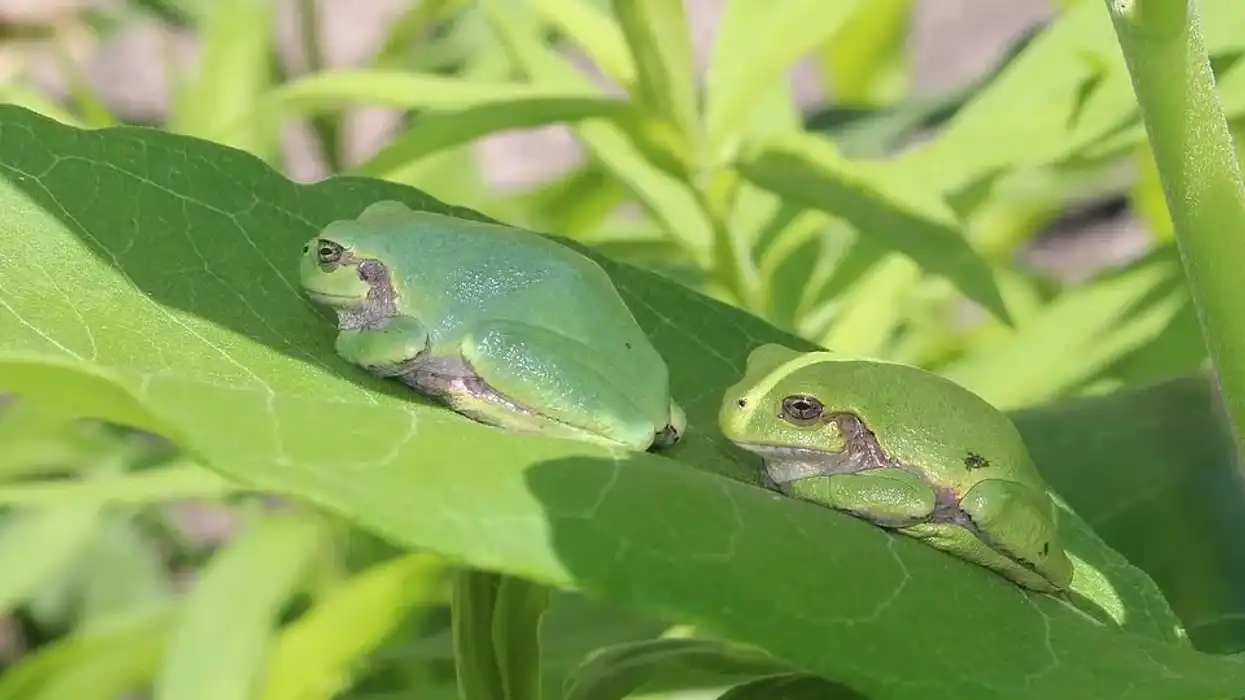The Japanese snapper (Paracaesio caerulea) was formally described in 1934 for the first time as Vegetichthy caeruleus by a Japanese zoologist Masao Katayama. Initially, the snapper locality given was Tokyo Fish Market and was believed to be caught in the vicinity of Hachijo-Jima in the Izu Islands.
The 'caerulea' in their name means 'blue', which is found on the back and side of the fish. In Japanese culture, the Japanese snapper is an important cuisine and is always available in the fish markets.
The fishing for the snapper is done using handlines and bottom longlines and is sold fresh in the market, and served whole.
In Japanese, this fish is also called 'aodai,' and its flesh is used for making sushi and sashimi. It is also prepared as soup with miso, deep-fried, broiled, or sauteed.
For more relatable content, check out these rockfish facts and gar facts for kids.
Japanese Snapper Interesting Facts
What type of animal is a Japanese snapper?
The Japanese snapper, Paracaesio caerulea, is a marine ray-finned snapper fish species found in southern Japan.
What class of animal does a Japanese snapper belong to?
The Japanese snapper, Paracaesio caerulea, belongs to the Actinopterygii class of the family Lutjanidae.
How many Japanese snappers are there in the world?
The Japanese snapper, or Tai, is one of the 105 snapper species of the family Lutjanidae. It is difficult to know the exact population of this deep-sea fish since the fish is also very popularly consumed and is hence, it is known that the snapper fish are found in abundance throughout the tropic.
Where does a Japanese snapper live?
The Tai fish is native to the western Pacific Ocean and is known only from southern Japan.
What is a Japanese snapper's habitat?
The Japanese snapper, Paracaesio caerulea, lives in demersal and marine environments at a depth of 328-1164.7 ft (100-355 m).
Who do Japanese snappers live with?
Snappers are known to live in groups called schools, which might consist of different snapper species or their own.
How long does a Japanese snapper live?
The Japanese snapper can live up to 60 years of age. Japanese snappers, or Tai fish, are known to mature between the age of three and five years.
How do they reproduce?
There is little information on their reproductive methods. However, it is known that the Tai fish reproduces through spawning.
Spawning is a process through which the fertilization of the eggs takes place externally. The spawning season for the Tai fish is thought to be April to September. It takes around three years for the Tai fish to double their population.
What is their conservation status?
The International Union for Conservation of Nature (IUCN) has declared the Japanese snapper, Paracaesio caerulea, as a Data Deficient species. A data deficient species is a species that does not have enough information about them for a proper assessment of their conservation status to be made. This does not mean that the particular species have not been studied.
Japanese Snapper Fun Facts
What do Japanese snappers look like?
 *Please note that this is an image of a Kasmira snapper that belongs to the same family as Japanese snapper. If you have an image of a Japanese snapper, please let us know at hello@kidadl.com.
*Please note that this is an image of a Kasmira snapper that belongs to the same family as Japanese snapper. If you have an image of a Japanese snapper, please let us know at hello@kidadl.com.Japanese snappers, or Tai fish, are very common fish consumed as food in Japan. This fish is white or silvery on its ventral side and has a blue color on its side and back.
Their dorsal and caudal fins are pale yellow in color, whereas their fins are either whitish or translucent, just like the color of their ventral side. They have a total of 10 dorsal spines and 10 dorsal soft rays; they also have three anal spines and eight anal soft rays.
The Tai fish has large eyes with a short snout which is about equal to or shorter than the eye diameter.
The Tai fish also has an interorbital space convex. Their pectoral fins are long, which reaches the level of their anus.
Their body also has scales like all other fish that are on their backside parallel to the lateral line. The Tai fish also has jaws that are equal in length and has bristle-like teeth in them.
How cute are they?
The Japanese snapper has a unique look. They are silver in color, which is beautiful. However, how cute the fish is, depends a lot on who sees it.
How do they communicate?
The method of communication used by the Japanese snapper has not been recorded. However, for mating and other activities, the snapper must use methods of communication that are used by other fishes as well.
How big is a Japanese snapper?
The Japanese snapper is 19.7 in (50 cm) in length, about the same length as the mutton snapper, from the same family as the Japanese snapper.
How fast can a Japanese snapper swim?
The speed at which the Japanese snapper can swim is not known exactly. However, the snapper has a constant threat from the big fishes that prey on them, and they must need to be fast enough to escape them.
How much does a Japanese snapper weigh?
Most snappers, on average, weigh between 4.4-11 lb (2-5 kg) which is almost the same as the barracuda fish, which preys on the snappers.
What are the male and female names of the species?
The male and female Japanese snapper fish do not have any separate names assigned to them.
What would you call a baby Japanese snapper?
Just like all baby fishes, the baby Japanese snapper fish is also called a fry.
What do they eat?
The only food choice of the Japanese snapper is zooplankton, making them carnivorous in nature.
Are they dangerous?
There are no known dangers of the Japanese snapper to humans or the ecosystem.
Would they make a good pet?
Since very little is known about the behavior and nature of the Japanese snapper, it is hard to tell if this fish would make a good pet or not. However, many other snapper species have been known to be kept as pets.
Did you know...
The Japanese snapper, along with other snappers, tuna, salmon, clams, yellowtail, squid, halibut, flounder, gizzard shad, scallops, mackerel, and sea bass are fishes that can be eaten in their raw state. These fishes are commonly consumed raw, and few of these are treated with vinegar or flash-steamed before being eaten. The Japanese snapper is served whole.
The red snapper is called 'madai' in Japanese. While snapper and sea bream might look similar, they belong to different families.
Why are snappers called snappers?
They are called snappers because of their big canine bristle-like teeth - 'snappers'. They also have a long triangular face with a sloping upper part which is stronger than the lower part. Moreover, they have equal jaws, but the lower one projects a little sometimes.
What is the largest species of snapper?
Out of the 105 snapper species in the world, the cubera snapper is the largest snapper to be caught in the waters. It is found in the waters of the South Atlantic, Gulf of Mexico, and the Caribbean sea.
It is tough to catch a cubera snapper, making them a very uncommon catch. But the few cubera snappers that were caught ranged between 8-30 lb (3.6-13.6 kg).
Here at Kidadl, we have carefully created lots of interesting family-friendly animal facts for everyone to discover! Learn more about some other fish from our king salmon interesting facts and blue tang surprising facts pages.
You can even occupy yourself at home by coloring in one of our free printable Japanese snapper coloring pages.
Main image by Jacopo Werther.
Second image by Albert Kok.
*Please note that the main image is of a red snapper that belongs to the same family as the Japanese snapper. If you have an image of a Japanese snapper, please let us know at hello@kidadl.com.




 *Please note that this is an image of a Kasmira snapper that belongs to the same family as Japanese snapper. If you have an image of a Japanese snapper, please let us know at hello@kidadl.com.
*Please note that this is an image of a Kasmira snapper that belongs to the same family as Japanese snapper. If you have an image of a Japanese snapper, please let us know at hello@kidadl.com.



